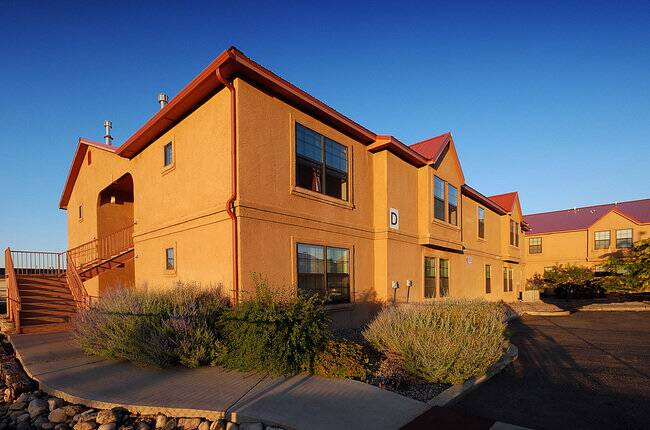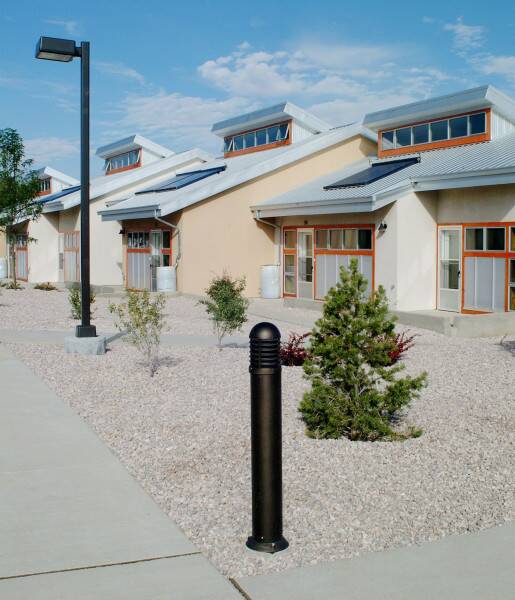LIHTC Applications FAQ 2024
This LIHTC Applications FAQ page is the method for submitting questions related to application requirements and scoring criteria for the current competitive low income housing tax credit allocation round. Staff will make a good faith effort to post responses to questions within three business days of receipt. Note that staff may edit questions for clarity before posting them to this page. If you believe that your question was misrepresented and your question was not answered correctly, please submit a follow-up question or clarification of your question. The deadline to submit a question is listed on the calendar for the current round.
- Question 1: If you are the local chapter of a national nonprofit organization, but your local chapter is a bona fide nonprofit organization registered in the state of New Mexico, would you qualify for points under Scoring Criterion No. 1?
- Answer: To qualify as a local nonprofit for points under Scoring Criterion No. 1, the local nonprofit must be a qualified, nonprofit organization with a board of directors comprised of a majority of New Mexico residents at the time the Application is submitted and was incorporated in New Mexico before January 1 of the year in which the Application is submitted, in this case on or before December 31, 2023. Therefore, if the “local chapter” you describe is incorporated, not merely registered as a foreign entity qualified to do business in the state of New Mexico, and that domestic nonprofit corporation meets all requirements of the Scoring Criterion, it could be eligible for points, assuming that proper documentation is included in the Application.
If the nonprofit organization does not meet the criteria to be eligible for points as a local nonprofit organization, it could still qualify for points under Tier 2 by having net worth/net assets of at least $2,000,000 and meeting the other criteria in the Scoring Criterion.
- Answer: To qualify as a local nonprofit for points under Scoring Criterion No. 1, the local nonprofit must be a qualified, nonprofit organization with a board of directors comprised of a majority of New Mexico residents at the time the Application is submitted and was incorporated in New Mexico before January 1 of the year in which the Application is submitted, in this case on or before December 31, 2023. Therefore, if the “local chapter” you describe is incorporated, not merely registered as a foreign entity qualified to do business in the state of New Mexico, and that domestic nonprofit corporation meets all requirements of the Scoring Criterion, it could be eligible for points, assuming that proper documentation is included in the Application.
- Question 2: If a blighted building has already been demolished on the site (at the request of the City), does the Project qualify for points?
- Answer: 2024 QAP Section III.E.17 states: “Projects that include the demolition of Blighted building(s)… are eligible for points under this criterion.” That the demolition of the Blighted Building must be part of the Project is further supported by the requirement that the Applicant “include a demolition budget.” If the building was previously demolished, there would be no need for a demolition budget.
Whether the demolition of the Blighted Building is part of the Project will depend on the facts and circumstances. For example, if the local jurisdiction put out a request for proposals for a site with a Blighted Building and required, as part of the development of the site, that the Blighted Building be immediately demolished when the Developer acquired the site, that demolition could be seen as part of the Project. On the other hand, if a Developer purchased a parcel of land and the seller demolished the Blighted Building at the request of the local jurisdiction, that demolition activity would not be considered to be part of the Project.
In addition, the square footage of the demolished Blighted Building must account for at least 10% of the Gross Square Feet of the entire completed Project and all required documentation would need to be included in the Application.
- Answer: 2024 QAP Section III.E.17 states: “Projects that include the demolition of Blighted building(s)… are eligible for points under this criterion.” That the demolition of the Blighted Building must be part of the Project is further supported by the requirement that the Applicant “include a demolition budget.” If the building was previously demolished, there would be no need for a demolition budget.
- Question 3: Requesting MFA approval for "Other - Enrichment Service Commitments" under the Seniors Housing Priority Scoring Detail Sheet for the following services:
- On-site semi-annual eligibility screenings and/or application assistance for Medicaid or Medicare (1 point).
- On-site quarterly technology training (1 point). Examples of technology training include tutorials on setting up smart phones, tablet instruction, social media training, computer training, internet browsing, taking and sharing photos, downloading apps or technology set-up assistance (connecting modems, etc.).- Answer: The following services are approved for one point each.
- On-site semi-annual eligibility screenings and/or application assistance for Medicaid or Medicare (1 point).
- On-site quarterly technology training (1 point). Examples of technology training include tutorials on setting up smart phones, tablet instruction, social media training, computer training, internet browsing, taking and sharing photos, downloading apps or technology set-up assistance (connecting modems, etc.).
- Answer: The following services are approved for one point each.
- Question 4: Tab 21a - Seniors Housing Priority Scoring Detail states a maximum of 8 points at the bottom of the points table. However, the QAP and the checklist (tab 1b, item 9) have a total of 10 maximum points for this housing priority.
- Answer: 2024 QAP Section III.E.9 provides up to ten points for the Projects Reserved for Seniors Housing Priority. A corrected application form has been uploaded to MFA’s website.
- Question 5: We plan to request a waiver under the 2024 Mandatory Design Standards related to the common area/common building requirement for our rehab project. If that request is granted, and the project subsequently does not include a common area, is the project ineligible to score any points under Scoring Criteria #10? The section states, “All Projects must include adequate common space for the provision of the proposed enrichment services.” There are area wide services available to the tenants and the Housing Authority office is located nearby. There are a variety of solutions available to the Housing Authority to serve those families, but not necessarily on-site in a project’s common space.
- Answer: All points under the Housing with Children Housing Priority are earned through the provision of on-site services, therefore the Project must have adequate on-site common space for the provision of the proposed enrichment services to earn any points under the Households with Children Housing Priority. The 2024 QAP Section III.E.10 states “To receive points under this housing priority, the Project Owner must certify that a service provider will be on-site a minimum of two days per week for a cumulative minimum total of ten hours per week. Enrichment services must be implemented within 90 calendar days following the issuance of a certificate of occupancy, optional to the residents, offered on-site [emphasis added] and be actively linked to the Project, not simply available to the community-at-large (e.g., Head Start) unless the on-site space where the program is held [emphasis added] qualifies as a community service facility under the Code. The proposed Project annual operating budget must include sufficient costs to cover the selected services and be detailed out in the submitted budget for serving this Housing Priority.”
-
Question 6: 2024 QAP Section III.E.4 Sustaining Affordability includes the statements:
“Projects currently without federal rental assistance that will have new federal rental assistance contract covering at least 75% of all Units.” (are eligible for 10 points)
“Projects that have or will have a federal rental assistance contract covering at least 20% of all Units are eligible for six points.”
Does “will have a federal rental assistance contract” include conditional commitments for Project Based Vouchers?
-
Answer: A conditional letter from a housing authority stating that the project will be eligible for PBV subject to an award of LIHTC can only be accepted for points under the Sustaining Affordability scoring criterion at Section III.E.4 if the Project received an award under a previous competitive process as explained below.
-
Federal rental assistance contracts are not signed before closing on all financing of a Project, therefore the QAP allows Projects that “will have a federal rental assistance contract” that are “adequately secured” to be considered in the LIHTC Application, both for points under Section III.E.4 and for underwriting purposes. To demonstrate that the PBV are “adequately secured” based on a competitive process administered by a housing authority, the Application must include each of the following documents:
- A copy of the PHA administrative plan which describes the selection procedures for owner submission of PBV and for PHA selection of PBV proposals
- A copy of the published public notice of the PBV proposal selected
- If the proposal selected is for PHA-owned units, a copy of the HUD field office or HUD-approved independent entity’s determination that the PHA-owned units were appropriately selected
- If the request for PBV is selected based on a previous competitive award that was not administered by the housing authority, MFA would require documentation that the commitment for PBV meets the criteria for selection without additional competition. For example, if a Project was awarded HOME funding through a local jurisdiction that competitively awards HOME funding, the award letter could be provided in lieu of the copy of the published public notice of the PBV proposal selected.
- If the Project did not receive an PBV award through a prior competitive process, the Project is not eligible for points under the Sustaining Affordability scoring criterion at Section III.E.4 and MFA is not able to consider PBV rents in the underwriting of the Project.
-
-
Question 7: To obtain max points for frequent transportation, the commuter bus must be within 0.25-mile walking distance with frequent scheduled service. The City of Roswell Transit bus operates on Main Street with Roswell Transit’s Dial-a-Ride service offering transportation to and from bus stops that are not part of the Main Street route. The Roswell Transit’s Dial-a-Ride service operates seven days a week on an as needed basis. Customers call in and the driver meets them at the bus stop location. The Main Street bus schedule has frequent stops less than an hour apart, Monday thru Friday. There is a Roswell Transit’s Dial-a-Ride service bus stop in front of our site. Please let me know if you need any additional information to confirm this bus stop qualifies for the max points (4) for frequent transportation under the QAP.
-
Answer: Access to public transportation points apply to “commuter bus stops (i.e. not Greyhound) or commuter rail … on a fixed route with scheduled service”. Additional points can be earned for “frequent scheduled service (defined as: any series of three or more single direction stops more frequent than every 1 hour, Monday – Friday).”
Dial-a-Ride service does not qualify for points for General and Rural or Frequent Transportation because there is no bus schedule offering “scheduled service on a fixed route”. Only fixed bus stops with scheduled service (i.e., providing a bus schedule with fixed bus stops) qualify for points.
-
- Question 1: Pertaining to IV.E.3. Limitation on tax credit awards to a single Project or Principal pg. 71, What is the distance between two projects where MFA would not consider them adjacent to each other?
Basis for this question is the following:
• We will be submitting two 9% applications in the 2024 round with each being 72-unit family developments on a 12-acre site.
• This 12-acre site is going to be subdivided into separate legal parcels for these two 72-unit family developments as well as a parcel for a 128-unit 4% family development.
• To ensure that these two 9% 72-unit family developments are not adjacent to each other, we would have a distinct and separate parcel between these two 9% site parcels that would have landscape, hardscape, playground and/or drainage basin.
This separate parcel would most likely be owned by the 128-unit 4% family development.- Answer: Section IV.E.3 limits the tax credits awarded to a single Project or Principal and states “[t]wo 9% LIHTC Projects to be located on adjacent sites proposed by the same Applicant in the same LIHTC Application round will be treated as a single Project.”
You have several options:
1. Pursue a Hybrid 9%/4% Development (See 2024 QAP Section II.U) on the entire 12-acre parcel that will include all 272 Units by increasing the number of 4% Units and reducing the number of 9% Units to meet the limitation on 9% tax credits in Section IV.E.3 of the 2024 QAP.
2. Reduce the size of one or both planned 9% projects and use the land to build the Units removed from the project(s) in a future year. In other words, the subdivided parcel would need to meet local government planning standards to build additional development (i.e., housing units or commercial development rather than landscape, hardscape, playground and/or drainage basin associated with a portion of the 272 units planned).
3. Have separate Applicants develop each 9% Project. The definition of Applicant in the QAP precludes entities that both participating in the partnership from applying separately as Applicants to develop adjacent parcels. However, two Developers without an identity of interest are permitted to develop properties that are adjacent to one another.
4. Only submit one of the two 72-Unit Projects in 2024 and submit the second one in a future round.
- Answer: Section IV.E.3 limits the tax credits awarded to a single Project or Principal and states “[t]wo 9% LIHTC Projects to be located on adjacent sites proposed by the same Applicant in the same LIHTC Application round will be treated as a single Project.”
- Question 2: According to the Mandatory Design Standards rehab projects must also include common space (community building). Is there any opportunity to secure a waiver of that requirement? If so, do we include the waiver request as part of the application?
- Answer: The 2024 Mandatory Design Standards for Multifamily Housing states: “In cases where it is not technically and/or economically feasible to adhere strictly to all design or submission requirements, individual requirements may be waived at MFA’s discretion. The applicant must complete and submit the Waiver Procedure for Design Requirements form found in the 2024 Universal Rental Development Application Package. This request will be reviewed with the Application and determination of approval given following the design review process.” The waiver request form is found at Tab 11 and is submitted with the Application.
- Question 3: We've conducted market studies for a proposed LIHTC project each of the past 3 years. The Developer intends to resubmit in early 2024 and has asked us to update our study. Can we update the study without making another site visit? (We would be comfortable with updating the surveyed apartment properties by telephone.)
- Answer: Another site visit is not required. MFA’s Market Study Parameters require that the date of the field work and site visit be included in the report, but an update of a recent existing report does not require an additional site visit if physical market conditions have not substantially changed.
- Question 4: Is a Phase I environmental review required for rehab projects?
- Answer: A Phase 1 environmental assessment is not a required exhibit in the 2024 LIHTC Application unless points are requested for a Brownfield, in which case the Phase 1 Environmental Site Assessment would be included with the required Phase II Environmental Site Assessment. However, Applicants may not commence construction on a Project prior to receipt of MFA’s written approval of complete construction documents for each source of MFA funding, including approval of any program-required environmental review clearances. A general description of applicable environmental reviews associated with MFA’s loans is included for reference at Tab 1a; these reviews are required after an award is made.
- Question 5: We understand that the 2024 Mandatory Design Standards for Multifamily Housing states:
“In cases where it is not technically and/or economically feasible to adhere strictly to all design or submission requirements, individual requirements may be waived at MFA’s discretion. The applicant must complete and submit the Waiver Procedure for Design Requirements form found in the 2024 Universal Rental Development Application Package. This request will be reviewed with the Application and determination of approval given following the design review process.”
May we request a waiver with our application of the Rehabilitation requirements under Section A. 3. A. – HERS Rating? Under that section it states that “Rehabilitation units shall achieve a post-construction HERS score of 65 or less.” We are working on our scope of work for the rehab but concerned about the ability to meet the post-construction HERS requirements without adding significant additional scope that may not be necessary other than to meet the HERS requirement.
- Answer: Where waivers are needed because it is not technically and/or economically feasible to adhere strictly to all design requirements, MFA may elect to grant a waiver. However,
To meet the criteria for a waiver for technical feasibility, the Applicant would need to demonstrate that it is not possible to meet the HERS rating, even after adding significant additional scope.
To meet the criteria for a waiver for economic feasibility, the Applicant would need to demonstrate that it is not possible to obtain the financial resources to meet the HERS rating.
- Answer: Where waivers are needed because it is not technically and/or economically feasible to adhere strictly to all design requirements, MFA may elect to grant a waiver. However,
- Question 6: According to the Mandatory Design Standards rehab projects must also include common space (community building). Is there any opportunity to secure a waiver of that requirement? If so, do we include the waiver request as part of the application?
- Answer: The 2024 Mandatory Design Standards for Multifamily Housing states: “In cases where it is not technically and/or economically feasible to adhere strictly to all design or submission requirements, individual requirements may be waived at MFA’s discretion. The applicant must complete and submit the Waiver Procedure for Design Requirements form found in the 2024 Universal Rental Development Application Package. This request will be reviewed with the Application and determination of approval given following the design review process.” The waiver request form is found at Tab 11 and is submitted with the Application.
- Question 7: Clarifying question on C. Minimum Project Threshold Requirements, 2. Zoning. Does the zoning letter on the proposed site(s) need to state it “does not prohibit multifamily” or may it state “does allow multifamily”?
- Answer: The 2024 QAP Section III.C.2 states that “[e]vidence that the current zoning of the proposed site(s) does not prohibit multifamily housing must be submitted.” The zoning letter may affirmatively state that multifamily housing is permitted. The purpose of the zoning letter is to document that the Project is an allowed use under the current “existing zoning of the site and that there is no pending litigation, pending variance, or unexpired appeal process relating to the zoning of the proposed site.”
-
Question 8: Under the 2024 QAP can a project apply for Additional Supplemental Tax Credits for Cost Increases (Section III.G) and Recycle the original tax credit allocation for the project (Section III.I)?
-
Answer: Yes. The 2024 QAP does not explicitly prohibit applications for Additional Supplemental Tax Credits for Cost Increases after a tax credit allocation is recycled.
Section III.G “Additional Supplemental Tax Credits for Cost Increases” states that the supplemental tax credits will not extend the Placed in Service deadline for the original award, thus an award of supplemental tax credits does not extend the Placed In Service deadline. However, an award of supplemental tax credits does not preclude a Project from requesting an extension to the Placed In Service deadline for the original award separately through a request to recycle the allocation under the terms and conditions found in Section III.I of the 2024 QAP.
-
-
Question 9: Under the 2024 QAP can a project that was placed in service in 2023 apply for Additional Supplemental Tax Credits for Cost Increases (Section III.G)?
-
Answer: Yes. Section III.G allows Projects to “apply for supplemental tax credits in a subsequent allocation round prior to issuance of an IRS Form 8609.” It does not prohibit a request for supplemental tax credits to cover cost overruns incurred during construction.
-
-
Question 10: 2024 QAP Section III.E.18 states “Projects which were awarded points for the Efficient Use of Credits Project Selection Criteria may not apply for additional tax credits if circumstances change unless the subsequent Application results in the same scoring range under Efficient Use of Credits when combined with the scoring range in the Initial Application. In other words, a subsequent request for additional tax credits shall not be granted if Applicant received points for the Efficient Use of Credits in a prior round and now exceeds the efficient use of credits scoring ranges when evaluating both Applications as one single Application.” From which QAP are the limits in the Efficient Use of Tax Credits applied for purposes of evaluating the combined total credits as one single Application? Is it the year of the original award or the 2024 QAP?
-
Answer: Since Section III.G indicates that the total amount of tax credits for the Project for the Project (including those previously awarded) shall not exceed the total credit available in Section IV.E.3 of the 2024 QAP, the evaluation of the Efficient Use of Credits is also based on the 2024 QAP.
Thus, the QAP can be read as follows:
“In other words, a subsequent request for additional tax credits shall not be granted if Applicant received points for the Efficient Use of Credits in a prior round and now exceeds the efficient use of credits scoring ranges when evaluating both Applications as one single Application based on the 2024 QAP.”
-
-
Question 11: If an Applicant requests Additional Supplemental Tax Credits for Cost Increases pursuant to 2024 QAP Section III.G, does the applicant need to provide a certificate demonstrating attendance at the 2024 QAP Training that was held October 26, 2023?
-
Answer: No. The Applicant must submit the Intent to Submit a Tax Credit Application described in Section III.C.7.a.i by December 20, 2023, the Application Fee found at Section IV.B, and the streamlined Application described in Section III.G. of the 2024 QAP that is available on MFA’s website.
-
-
Question 12: Does MFA have a preferred form of attorney’s opinion related to the 10-year rule?
-
Answer: MFA does not publish a form of attorney’s opinion related to the 10-year rule.
-
-
Question 13: Our project is based on a city RFP for affordable housing developers that was won over two years ago. The company [entity] that won the RFP is being dissolved as it was used for another deal. Accordingly, the QAP [Application] will reference a newco [new entity] as the owner. We are having the original RFP assigned to the newco. Three of the four parties to that original RFP are involved in this newco. That RFP is instrumental in securing PBV [project-based vouchers] for our proposed project, and we are inquiring whether the assignment process described will be satisfactory to MFA.
-
Answer: If the request for PBV is selected based on a previous competitive award that was not administered by the housing authority, MFA would require documentation that the commitment for PBV meets the criteria for selection without additional competition. Such documentation would include, at minimum:
-
From the city:
- A copy of the city RFP
- A copy of published notice of the award (or similar public notice such as city council minutes)
- A copy of the assignment of the award to the new entity
- From the housing authority:
- A PBV award letter from the housing authority issuing the PBV that includes:
- the number of PBV allocated to the Project;
- A statement that the award through the city’s RFP process and subsequent assignment of the award satisfies HUD’s requirements to issue the PBV and that no further competition is necessary.
- The housing authority published rent schedule that includes the anticipated rents for the PBV units;
- The current housing authority published utility allowance schedule;
- Housing Authority Administrative Plan
- Published legal notice of selection of the application for PBV
-
-
Question 14: Relocation – we believe the General Info Notices would not track to the LIHTC application date, but rather, the date of application for Nat’l Housing Trust Fund, HOME, and CDBG programs when those gap source application fees are due and the preliminary LIHTC award letters have been released. We would prefer not to cause tenants anxiety at this early stage.
If we supply under tabs 36a and 37d – only current rent roll, sample GIN (that will go out to tenants at a later date but prior to applying for gap sources), and relo plan, will this satisfy this checklist item as complete?
-
Answer: No. For purposes of the LIHTC, only a sample General Information Notice (GIN) is required: “This relocation plan must include a sample tenant letter outlining the process and informing the tenant of any potential permanent displacement due to a change in unit mix or income ineligibility.”(2024 QAP Section II.J.3)
MFA added the GINs to the application checklist in 2022 after its review of the Uniform Relocation Act (URA) at 49 CFR 24 and regulatory guidance provided by HUD in Handbook 1378. Therefore, if the Applicant is applying for the federal National Housing Trust Fund and/or HOME funds with the LIHTC the GIN must be provided. Thus, the checklist at Tab 1a indicates that the tenant signed copies of the GIN be included with the application at Tabs 36a and 37d. Applicants may deliver the notice in person and obtain a signature certifying receipt of the notice by going door to door, or via certified return receipt through the US Postal Service.
HUD Handbook 1378 explains that the Initiation of Negotiations (ION) date serves as a milestone in determining a person’s eligibility for relocation assistance, including moving costs and a replacement housing payment. The ION date is the trigger for issuance of the Notice of Eligibility for Relocation Assistance or Notice of Nondisplacement.
The HOME program specific definition of the initiation of negotiations at 24 CFR 92.353(c)(3) indicates that the initiation of negotiations “…to a tenant displaced…as a result of private-owner rehabilitation, demolition or acquisition…the execution of the agreement covering the acquisition, rehabilitation, or demolition.” In other words, when the Applicant signed the purchase and sale agreement or option, that event triggered the ION and the need to provide a GIN to each tenant notifying them about the project, planned development, timeline and potential displacement because the URA regulations at 49 CFR 24.203(a) require that persons who are scheduled to be displaced must be provided with a GIN as soon as feasible.
The flowchart in HUD Handbook 1378 CHG-3 Appendix 1 included sending the General Information Notice to tenants cautioning them not to move before the MFA reviews the application for federal funding. Upon execution of the loan agreement for federal funding, the developer delivers more specific notices to tenants informing them whether they will be displaced as a result of the proposed project.
Many HUD projects can involve both persons who are actually displaced and persons who are not displaced. In most programs, if the tenant-occupant of a dwelling moves permanently from the property after submission of an application for HUD financial assistance, the tenant will be presumed to qualify as a “displaced person.” To minimize such unintended displacements, HUD policy considers all occupants within a proposed HUD-assisted project involving acquisition, rehabilitation or demolition as scheduled to be displaced for purposes of issuing a GIN. (See 24 CFR 92.353(c)(2)(C)(1)) All occupants, therefore, must be provided with a GIN. For those persons the Applicant does not plan to displace, this GIN should be modified to explain that the project has been proposed, explain that they will not be displaced, and caution the person not to move (complete with an explanation of the ramifications of moving on his/her own).
-
-
Question 15: Regarding the Compliance Affidavits: The QAP defines “Principal” means an Applicant, any general partner of an Applicant, and any officer, director, board member or any shareholder, general partner, managing member, or affiliate of an Applicant. It also includes any entity receiving any part of a developer fee for a Project. For Project compliance purposes (Section IV.C.8), Principal would include shareholders with interests of 25% or more, all officers of a corporation (including employees, but excluding volunteer board members with no financial interest), all General Partners or members.
The checklist instructions states: “Principal” means an Applicant, any general partner of an Applicant, and any officer, director, board member or any shareholder, general partner, managing member, or affiliate of an Applicant. It also includes any entity receiving any part of a developer fee for a Project. For Project compliance purposes (Section IV.C.8), Principal would include shareholders with interests of 25 percent or more, all officers of a corporation (whether Board members or employees), all general partners or members.
If we are a NM non-profit corporation and our board is comprised solely of volunteer members with no financial interest, do the board members need to sign a compliance affidavit?
-
Answer: In previous years, all officers of a corporation (Board members or employees), were required to complete a compliance affidavit. However, in all instances where volunteer board members are referred to in the 2024 QAP and accompanying exhibits, volunteer board members with no financial interest in the Project are excluded from the requirement to complete a compliance affidavit.
Therefore, volunteer board members with no financial interest, including those serving as officers of a New Mexico nonprofit corporation, are not required to complete a compliance affidavit. However, the executive director and any other employees who are authorized to sign documents on behalf of the nonprofit corporation would be considered to be officers for purposes of the compliance affidavit and must complete a compliance affidavit.
-
-
Question 16: We are still confirming some numbers related to submitting our projects as 4% deals, but we don't want to miss out on submitting the projects in this round if that doesn't work. Is it permissible for us to submit both projects as 9% applications, and if we find they are doable as 4% deals, pull the 9% application to submit as a 4% instead? Or, if they're not awarded as 9% projects can we resubmit them as 4% projects?
-
Answer: Applicants are welcome to restructure a Project that did not receive an award in the 9% round for consideration as a 4% LIHTC Project by submitting a new 4% LIHTC Application after the MFA Board meets to approve the 9% awards. If the Applicant wishes to restructure a 9% LIHTC Project and submit a 4% LIHTC Application any time before the MFA Board formally approves awards in May, the 9% LIHTC Application would need to be formally rescinded (in writing) before MFA can communicate with the Applicant regarding the 4% LIHTC Application and/or any associated requests for MFA gap financing.
-
-
Question 17: The checklist has a duplicate tab number. Tab 16o is under qualified non-profit for the QAP certificates and under NMHA/TDHE articles of incorporation. Do you want the duplicate numbering or should the o-w under NMHA be shifted down one letter?
-
Answer: An updated Application has been posted on the website with the numbering shifted down one letter so that Tab 16 has exhibits a through x (preferred). However, Applicants who duplicate the numbering of Tab 16o will not be penalized in the 2024 9% LIHTC round.
-
-
Question 18: Are there additional rehabilitation requirements for projects utilizing National Housing Trust Fund funding?
On page 7 of the MFA 2024 Mandatory Design Standards for Multifamily Housing Part A, Rehabilitation/A. General Design is stated "Appendix A removed from NHTF rehab requirements. This section is no longer applicable."
On page 18 of Part B: MFA 2024 Submission Instructions for Preliminary Architectural Documentation for Multifamily Housing Applications, Site Information, 13. states "For projects utilizing National Housing Trust Fund funding, a certification that the design is in compliance with all the requirements of the State of New Mexico National Housing Trust Fund Rehabilitation Standards".
Part A and Part B are conflicting. The LIHTC application will include a request for National Housing Trust Fund funding. Requesting clarification of what is required.
-
Answer: The State of New Mexico National Housing Trust Fund Rehabilitation Standards (NHTF Rehab Standards) are separate standards that were approved by HUD in 2020 for New Mexico’s NHTF. HUD requires that the rehabilitation meet or exceed the NHTF Rehab Standards. The supplement referred to on page 7 of the 2024 MFA Mandatory Design Standards for Multifamily Housing (2024 Standards) is not part of the 2024 Standards document. Acquisition/Rehabilitation Projects financed with NHTF must meet both the 2024 Standards and the NHTF Rehab Standards. Where the two sets of standards differ, the more rigid standard must be included in the scope of work for the Project.
The NHTF Rehab Standards are available for download with the other 2024 Tax Credit Round materials.
-
-
Question 19: For rehab properties, will MFA accept the HERS Score of 65 as a weighted average across all unit types? Our proposed project, for example, has 8 total single family plan types. This is the recommended solution via our energy consultant because it essentially delivers a HERS Score for an overall project as opposed to an individual unit type. Other states such as Arizona have written the weighted average language into their QAP to address concerns.
-
Answer: MFA’s Design Standards on page 8 states that “rehabilitation units shall achieve a post-construction HERS score of 65 or less.” Each unit is tested and must be at or under the required HERS score.
-
- Question 1: I have a question about a resyndication application. If the owner is successful in obtaining an award of credits to resyndicate the project they intend to comply with the current LURA until it expires at the end of its 45 year commitment. What we are wanting to confirm is the following; Is it allowable to select a lesser restrictive unit AMI mix in the new application?
For example:
• Current Unit Mix: 8 units @ 40% AMI; 24 units @ 50% AMI; 8 units @ 60% AMI
• Potential Application Unit Mix: 10 units @ 50% AMI;30 units @ 60% AMI*
*Subject to change
The owner would continue following the more restrictive AMI unit mix in the original LURA and the new AMI unit mix would not be applicable to the project until the original LURA expires. We just want to verify that the application for the new award of credits would not be disqualified if we do not select the same AMI unit mix that was promised in the original LURA.
- Answer: An Applicant with an existing Project with deeper income restriction targeting will not automatically be disqualified from the 9% LIHTC round if the proposed rent and income restrictions conform with what is currently allowable. However, the existing rent and income restrictions will not be lifted until the existing LURA has expired.
- Question 2: Question regarding the 2024 Underwriting Supplement. There is an inconsistency about the amortization of the NMHTF loans. The guide says to use a 30-year amortization (pg 3), but the term sheet says 40-year amortization (pg 10). If you would please clarify the amortization for NMHTF loans.
- Answer: The amortization period for the New Mexico Housing Trust Fund is up to forty (40) years. The 2024 Underwriting Supplement posted on MFA’s website has been updated for consistency.
-
Question 3: I’m trying to input 3b – Sources of Funds. In row 10, I was using a HOME Loan at 0% interest rate. It returns a $0 payment. When I dump 1% in there, it gives a payment, so I’m feeling like a formula problem exists. I can overwrite, but don’t want to get in trouble for doing so. Any thoughts on how to proceed?
-
Answer: The formula is designed for loans with interest rates higher than 0%. You can overwrite the blue box with the HOME payment. It’s the loan amount divided by 40. The page is unlocked to allow for this sort of flexibility.
-
-
Question 4: Page 11 of the 2024 QAP states "Any assumed debt must be reflected in Schedule A-1 and Schedule C-1 (cash flow). Any debt to be paid off must be reflected as a use in Schedule A-1." May we have some clarification as we will not assume or have partial debt, and is the paid off debt to be listed as a "use" in this case?
-
Answer: Applicants should explain whether existing financing on the property to be acquired will be paid off at closing or assumed as part of the Project’s financing in the Project Narrative inserted at Tab 1d. All existing financing sources that will remain in the Project’s capital stack must be listed on Schedule A-1 – Sources of Financing. All Project costs must be listed on Schedule A – Development Cost Budget. Schedules A and A-1 must balance. The full purchase price of the land and/or buildings is listed on lines 1 and 2 of Schedule A, as applicable. If the current owner will repay all existing financing through the sale of the property, there is no need to list that financing on Schedule A or Schedule A-1.
-
-
Question 5: Can MFA confirm that relocation expenses are basis eligible? Our understanding is that they are basis eligible. However, the Part II Companion Schedules, 3a Dev Cost Budget (A) reduces basis by line 75 'Hard Relocation Costs' in the formula in cell G78
-
Answer: MFA accepts hard relocation costs as part of Eligible Basis; thus the cell is not shaded. The schedule is not locked. Therefore, you may adjust the formula in cell G78 to reflect that reality. MFA uploaded an updated Application for those who feel uncomfortable adjusting the formula.
-
-
Question 6: Requesting clarification on NM Housing Trust Fund underwritten interest rate.
On page 3 of the MFA 2024 Universal Multifamily Initial Underwriting Supplement, Subordinate Must-Pay Debt: "MFA NM Housing Trust Fund loans may be underwritten at 3% interest and up to a 40-year amortization".
On page 10, New Mexico Housing Trust Fund Term Sheet, Underwriting: Interest Rate - "MFA may, in its sole discretion, set interest rates on NMHTF. See the program webpage on MFA's website...for current rates according to project type".
The website indicates we may use a 2% interest rate as the project we are applying for is Senior, Rural, and no current LIHTC awards in the last 5 years.
Please confirm if we may underwrite to the 2% provided on the NMHTF website.
-
Answer: MFA is not able to prejudge an application. However, you may follow the direction from MFA’s website regarding interest rates on the New Mexico Housing Trust Fund:
“9% Low Income Housing Tax Credit (LIHTC) Projects:
Base interest rate of 3%. May allow for a 1% discount for rural, senior, tribal, and permanent supportive projects. Generally, the interest rate for 9% LIHTC projects will be no less than 2%.*
* Projects located in an Underserved Area (areas that have not received MFA funding in the last five years) may receive an additional discount of 1%. If loan request exceeds construction and/or permanent funding limits, MFA will increase base interest rate by 1%.”
-
- Question 1: I’m looking to see if MFA has updated Average Income Policy/Guidance since Federal Guidance was released late last year. I was unable to find a Compliance Manual on the website, so I’m not sure if it would be within a Manual or if you have a separate policy/regulation released elsewhere.
- Answer: MFA’s (non-scoring) policies regarding Average Income can be found in the 2024 QAP:
In Section II.E.3 “Minimum Apartment Unit Set-Asides” beginning on page 5
In Section IV.B where Monitoring and Compliance Fees are listed on page 59
In Section X.D “Annual Certification Review” on page 91
MFAs LIHTC Compliance Plan dated December 30, 2021 can be downloaded from the following URL:
https://housingnm.org/property-owners-agents-and-managers/lihtc-compliance-plan-and-appendices
If you have further questions regarding compliance, you may contact MFA’s Asset Management Department at assetmanagement@housingnm.org
- Answer: MFA’s (non-scoring) policies regarding Average Income can be found in the 2024 QAP:











